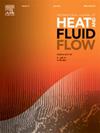A generalisable data-augmented turbulence model with progressive and interpretable corrections for incompressible wall-bounded flows
IF 2.6
3区 工程技术
Q2 ENGINEERING, MECHANICAL
International Journal of Heat and Fluid Flow
Pub Date : 2025-07-23
DOI:10.1016/j.ijheatfluidflow.2025.109970
引用次数: 0
Abstract
The integration of interpretability and generalisability in data-driven turbulence modelling remains a fundamental challenge for computational fluid dynamics applications. This study yields a generalisable advancement of the - Shear Stress Transport (SST) model through a progressive data-augmented framework, combining Bayesian optimisation with physics-guided corrections to improve the predictions of anisotropy-induced secondary flows and flow separation simultaneously. Two interpretable modifications are systematically embedded: (1) a non-linear Reynolds stress anisotropy correction to enhance secondary flow predictions, and (2) an activation-based separation correction in the -equation, regulated by an optimised power-law function to locally adjust turbulent viscosity under adverse pressure gradients. The model is trained using a multi-case computational fluid dynamics-driven a posteriori approach, incorporating periodic hills, duct flow, and channel flow to balance correction efficacy with baseline consistency. Validation across multiple unseen cases – spanning flat-plate boundary layers, high-Reynolds-number periodic hills, and flow over diverse obstacle configurations – demonstrates enhanced accuracy in velocity profiles, recirculation zones, streamwise vorticity, and skin friction distributions while retaining the robustness of the original - SST in attached flows. Sparsity-enforced regression ensures reduced parametric complexity, preserving computational efficiency and physical transparency. Results underscore the framework’s ability to generalise across geometries and Reynolds numbers without destabilising corrections, offering a validated framework toward deployable, data-augmented turbulence models for numerical simulations.
不可压缩壁面流动的具有渐进和可解释修正的广义数据增强湍流模型
在数据驱动的湍流建模中,如何整合可解释性和通用性仍然是计算流体动力学应用的一个基本挑战。本研究通过一个渐进的数据增强框架,将贝叶斯优化与物理导向修正相结合,提高了对各向异性诱导的二次流和流动分离的预测,从而对k-ω剪切应力输运(SST)模型进行了推广。系统地嵌入了两个可解释的修正:(1)非线性雷诺应力各向异性校正,以增强二次流预测;(2)ω方程中基于活化的分离校正,由优化的幂律函数调节,以局部调节逆压梯度下的湍流粘度。该模型使用多案例计算流体动力学驱动的后验方法进行训练,结合周期性山丘、管道流动和通道流动,以平衡校正效果和基线一致性。跨越平板边界层、高雷诺数周期山丘和跨越不同障碍物配置的流动等多个未见情况的验证,证明了速度剖面、再循环区域、流向涡度和表面摩擦分布的准确性提高,同时保留了附加流动中原始k-ω海表温度的鲁棒性。稀疏性强制回归确保降低参数复杂性,保持计算效率和物理透明性。研究结果强调了该框架在不破坏稳定修正的情况下对几何形状和雷诺数进行推广的能力,为数值模拟的可部署、数据增强的湍流模型提供了一个经过验证的框架。
本文章由计算机程序翻译,如有差异,请以英文原文为准。
求助全文
约1分钟内获得全文
求助全文
来源期刊

International Journal of Heat and Fluid Flow
工程技术-工程:机械
CiteScore
5.00
自引率
7.70%
发文量
131
审稿时长
33 days
期刊介绍:
The International Journal of Heat and Fluid Flow welcomes high-quality original contributions on experimental, computational, and physical aspects of convective heat transfer and fluid dynamics relevant to engineering or the environment, including multiphase and microscale flows.
Papers reporting the application of these disciplines to design and development, with emphasis on new technological fields, are also welcomed. Some of these new fields include microscale electronic and mechanical systems; medical and biological systems; and thermal and flow control in both the internal and external environment.
 求助内容:
求助内容: 应助结果提醒方式:
应助结果提醒方式:


